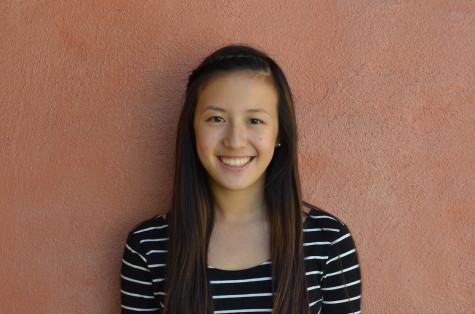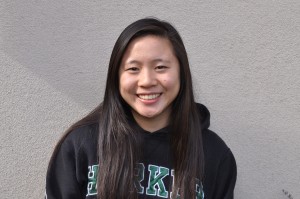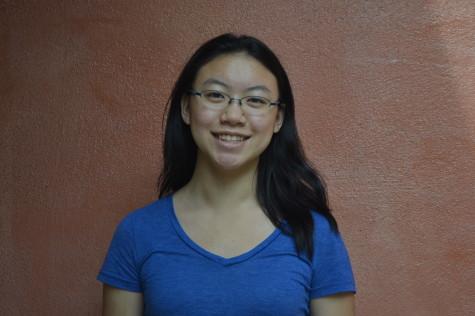Q&A with Stanford-bound synchronized swimmer Katie Gu

Katie Gu
Katie Gu is thrown out of the water by her teammates. She is planning on synchronized swimming at Stanford and is training for the 2016 Olympics in Rio.
For Katie Gu (12), a typical Saturday does not include catching up on the week’s TV shows or shopping with some friends. Instead, her competitive synchronized swimming schedule fills her Saturdays, spending nine hours training in the water and on land. Harker Aquila sat down with Katie to discuss her passion for synchronized swimming and her future plans, including attending the 2016 Olympics in Rio.
Harker Aquila: How does synchronized swimming work?
Katie Gu: The way synchro works is usually there are different events. There’s teams, solos, duets and combos. The most popular event is the team event and that is of eight members of the team. There aren’t really any positions. It’s kind of just members and I’m usually the flyer though so as you can see in the pictures, I usually go off the lifts.
HA: When did you start swimming and what made you start?
KG: When I was younger I did both ballet and speed swimming. I wasn’t particularly interested in either and my mom noticed that at swim practice, I just kind of goofed off and would do flips underwater. I think when I was about seven or eight, my speed swimming coach told me about the Aquamaids. Synchro just sounded like the perfect sport for me, so I joined the next year.
HA: What part of swimming makes you want to practice everyday? Why do you keep doing it? What’s your favorite part?
KG: One thing that’s really nice is that you can actually see your hard work pay off. Usually when you’re at school and you study really hard and you don’t do well on a test, you don’t see any of your effort . I feel like when I swim, everything that I put in I see it reflected and I like that a lot. Also, my teammates are obviously really supportive. It’s nice to be working with people that have similar goals as you and who are working as hard as you.
HA: How does synchronized swimming fit into your schedule?
KG: Usually on weekdays we practice from anywhere between three to eight and the way it works is that usually we have land training in the beginning so sometimes we do yoga, sometimes we do stretching, sometimes we’ll do acro. Then, we swim and work on our routines or choreograph for the rest of practice. Our longest training days are usually the weekends, so Saturdays. This Saturday, I have from seven to three, and Sunday I have seven to four.
HA: How do you manage to combine swimming with the workload here?
KG: That’s always been challenging. Junior year was definitely pretty tough. The demands from both my teachers and my coaches are really conflicting in that I need to be able to simultaneously juggle the high academic standards here at Harker and the training expectations at the pool. But I think building strong relationships with my teachers, who have all been incredibly understanding and supportive, has helped me enormously through the years. Also, I’ve found that the most valuable part of being introduced to sports early is that I’ve been able to develop a pretty good sense of time management . Learning to keep myself consistently on task and maintain my priorities has definitely helped me balance both school and synchro. That said, it does get tough when I’m sick or have a ton of schoolwork, because there just aren’t a lot of practices I can afford to miss.
HA: Is there a specific reason why you chose Stanford?
KG: There are three of four universities with the biggest synchro teams in the country. The top three are Ohio State, Stanford, and Incarnate [University of Incarnate Word]. Stanford’s been my goal for as long as I can remember; it’s really got the whole package: the stellar academics and the elite synchro team. Choosing Stanford was really a no-brainer for me.
HA: What are you most excited about swimming at Stanford?
KG: The team and the coaches at Stanford are all crazy talented. Stanford’s athletic facilities are incredible, and the resources the university has for student-athletes are fantastic. Because Stanford’s very attentive to what you need for your studies, it’s easy to communicate back and forth between professors and coaches. I’m looking forward to training towards my goals in synchro all while receiving an unparalleled education. I’m also currently part of the USA senior national team. If I am selected again next year, I’ll be able to train both with the national team and Stanford, which would be an amazing experience.
HA: Do you see swimming as a big part of your life in the next 4 years? Do you see yourself going to 2016?
KG: That’s a major goal of mine. Unfortunately, the USOC changed their qualification guidelines for synchro recently so that only one country from each continent can attend the Games. Last year, the US team didn’t qualify for the Olympics. The current national team is training very intensely to bring the US back to the top. Although academics are very important to me, I aim and plan to work towards Rio.
HA: What advice do you have for aspiring athletes who want to play at the collegiate level?
KG: It’s really important to know what you want. You have to make sure it’s something that you want to do because once you commit yourself to it it’s a hard path to stray from. Just to get to know the coach. I contacted my coach pretty early on in the season. Let the coaches know your strengths and what you can contribute to the team.

Shannon Su is the Managing Editor and Executive News Director of Harker Aquila. She joined the program as a reporter her freshman year and has held many...

Mercedes Chien is the design editor for The Winged Post. This is her fourth year in the program and previous positions she's held include Photography and...

Kacey Fang (12) is the Managing Editor for The Winged Post. She has been part of the journalism program since freshman year and served as Features Editor...


















![“[Building nerf blasters] became this outlet of creativity for me that hasn't been matched by anything else. The process [of] making a build complete to your desire is such a painstakingly difficult process, but I've had to learn from [the skills needed from] soldering to proper painting. There's so many different options for everything, if you think about it, it exists. The best part is [that] if it doesn't exist, you can build it yourself," Ishaan Parate said.](https://harkeraquila.com/wp-content/uploads/2022/08/DSC_8149-900x604.jpg)




![“When I came into high school, I was ready to be a follower. But DECA was a game changer for me. It helped me overcome my fear of public speaking, and it's played such a major role in who I've become today. To be able to successfully lead a chapter of 150 students, an officer team and be one of the upperclassmen I once really admired is something I'm [really] proud of,” Anvitha Tummala ('21) said.](https://harkeraquila.com/wp-content/uploads/2021/07/Screen-Shot-2021-07-25-at-9.50.05-AM-900x594.png)







![“I think getting up in the morning and having a sense of purpose [is exciting]. I think without a certain amount of drive, life is kind of obsolete and mundane, and I think having that every single day is what makes each day unique and kind of makes life exciting,” Neymika Jain (12) said.](https://harkeraquila.com/wp-content/uploads/2017/06/Screen-Shot-2017-06-03-at-4.54.16-PM.png)








![“My slogan is ‘slow feet, don’t eat, and I’m hungry.’ You need to run fast to get where you are–you aren't going to get those championships if you aren't fast,” Angel Cervantes (12) said. “I want to do well in school on my tests and in track and win championships for my team. I live by that, [and] I can do that anywhere: in the classroom or on the field.”](https://harkeraquila.com/wp-content/uploads/2018/06/DSC5146-900x601.jpg)
![“[Volleyball has] taught me how to fall correctly, and another thing it taught is that you don’t have to be the best at something to be good at it. If you just hit the ball in a smart way, then it still scores points and you’re good at it. You could be a background player and still make a much bigger impact on the team than you would think,” Anya Gert (’20) said.](https://harkeraquila.com/wp-content/uploads/2020/06/AnnaGert_JinTuan_HoHPhotoEdited-600x900.jpeg)

![“I'm not nearly there yet, but [my confidence has] definitely been getting better since I was pretty shy and timid coming into Harker my freshman year. I know that there's a lot of people that are really confident in what they do, and I really admire them. Everyone's so driven and that has really pushed me to kind of try to find my own place in high school and be more confident,” Alyssa Huang (’20) said.](https://harkeraquila.com/wp-content/uploads/2020/06/AlyssaHuang_EmilyChen_HoHPhoto-900x749.jpeg)


